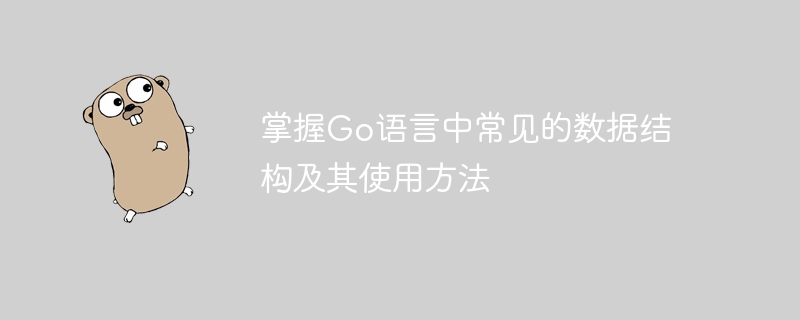

To master common data structures and their usage in Go language, specific code examples are required
In Go language, data structure is a way to organize and store data. Way. Mastering common data structures and how to use them is crucial to developing efficient programs. This article will introduce common data structures in Go language and provide specific code examples.
Code example:
package main
import "fmt"
func main() {
// 创建一个长度为5的整数数组
var arr [5]int
// 给数组赋值
for i := 0; i < len(arr); i++ {
arr[i] = i * i
}
// 打印数组的值
for _, value := range arr {
fmt.Println(value)
}
}Code example:
package main
import "fmt"
func main() {
// 创建一个空切片
var slice []int
// 给切片添加元素
slice = append(slice, 1)
slice = append(slice, 2)
slice = append(slice, 3)
// 打印切片的容量和长度
fmt.Println("Capacity:", cap(slice))
fmt.Println("Length:", len(slice))
// 打印切片的值
for _, value := range slice {
fmt.Println(value)
}
}Code example:
package main
import "fmt"
type Node struct {
data int
next *Node
}
type LinkedList struct {
head *Node
}
func (list *LinkedList) add(data int) {
newNode := &Node{data: data}
if list.head == nil {
list.head = newNode
} else {
current := list.head
for current.next != nil {
current = current.next
}
current.next = newNode
}
}
func main() {
linkedList := &LinkedList{}
linkedList.add(1)
linkedList.add(2)
linkedList.add(3)
current := linkedList.head
for current != nil {
fmt.Println(current.data)
current = current.next
}
}Code example:
package main
import "fmt"
type Stack struct {
data []int
}
func (stack *Stack) push(value int) {
stack.data = append(stack.data, value)
}
func (stack *Stack) pop() int {
if len(stack.data) == 0 {
return -1
}
value := stack.data[len(stack.data)-1]
stack.data = stack.data[:len(stack.data)-1]
return value
}
func main() {
stack := &Stack{}
stack.push(1)
stack.push(2)
stack.push(3)
value := stack.pop()
for value != -1 {
fmt.Println(value)
value = stack.pop()
}
}Code examples:
package main
import "fmt"
type Queue struct {
data []int
}
func (queue *Queue) enqueue(value int) {
queue.data = append(queue.data, value)
}
func (queue *Queue) dequeue() int {
if len(queue.data) == 0 {
return -1
}
value := queue.data[0]
queue.data = queue.data[1:]
return value
}
func main() {
queue := &Queue{}
queue.enqueue(1)
queue.enqueue(2)
queue.enqueue(3)
value := queue.dequeue()
for value != -1 {
fmt.Println(value)
value = queue.dequeue()
}
}The above code examples cover common data structures in Go language and how to use them. By learning and mastering these data structures, the efficiency and readability of the program can be improved. I hope this article will be helpful for you to learn the data structure of Go language.
The above is the detailed content of Learn to use common data structures and their methods in Go language. For more information, please follow other related articles on the PHP Chinese website!
 Usage of Type keyword in Go
Usage of Type keyword in Go
 How to implement linked list in go
How to implement linked list in go
 What are the Go language programming software?
What are the Go language programming software?
 How to learn go language from 0 basics
How to learn go language from 0 basics
 Usage of treenode
Usage of treenode
 What are the methods to implement operator overloading in Go language?
What are the methods to implement operator overloading in Go language?
 What are the operators in Go language?
What are the operators in Go language?
 The difference between concat and push in JS
The difference between concat and push in JS




